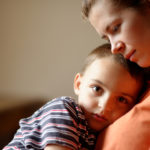We have a growing number of studies looking at the reproductive safety of antipsychotic medications, specifically atypical or second generation antipsychotic agents. Most of these studies have focused on risk of malformations related to exposure, and we have less data on the impact of prenatal antipsychotic medication exposure on long-term neurodevelopmental outcomes in children. Two recent studies — both of them from Denmark — add to the medical literature and provide reassuring information to women using this class of medications.
Neurodevelopmental Assessment in School-Aged Children
In this study, Schrijver and colleagues performed a cross-sectional neurodevelopmental assessment of 91 children between the ages of 6 and 14 years whose mothers had severe mental illness and were either exposed (n=17) or unexposed (n=74) to antipsychotic medication during pregnancy. Neurodevelopmental outcomes were assessed using validated instruments to examine the child’s IQ and global cognitive functioning. The presence of any psychiatric symptoms and/or learning problems in the children were assessed using parental reports.
The researchers found no statistically significant associations between antipsychotic exposure during pregnancy and adverse neurodevelopmental outcomes (IQ, neuropsychological function). Nor did they find any association between exposure and risk for psychiatric illness or learning problems.
This study is limited by its small sample size and may not be able to identify subtle changes in neurodevelopmental functioning; however, its strength is that it utilized validated, standardized assessments to assess outcomes.
Performance on Standardized Testing in Danish Children
Liu and colleagues used Danish register-based data to examine the association between prenatal exposure to antipsychotic medications and performance of children on standardized testing spanning from 8.9 (SD 0.4) years in second grade to 14.9 (SD 0.4) years in eighth grade.
This register-based cohort study included 667,517 children born in Denmark between January 1997 and December 2009 who were attending public schools. All children had completed at least one language or mathematics test as part of the Danish National School Test Program between 2010 and 2018. Pregnant individuals who filled antipsychotic prescriptions were identified using the Danish National Prescription Register.
Of the 667,517 children included in this cohort (51.2% males), 1442 (0.2%) children were born to mothers filling an antipsychotic prescription during pregnancy. Children born to mothers who had filled a prescription for an antipsychotic medication did not differ from unexposed children in terms of performance on language or mathematics tests. These findings were not affected by the timing of exposure or by the class of antipsychotic medication (first- vs. second-generations) used. The most commonly prescribed antipsychotic monotherapies included chlorprothixene, flupentixol, olanzapine, zuclopenthixol, quetiapine, perphenazine, and methotrimeprazine. The results remained robust after controlling for potential confounders, including sibling-controlled analyses.
What Should We Tell Our Patients
Clinically, we have seen an increasing number of women taking antipsychotic medications, particularly the newer second generation or atypical agents, but have limited information regarding the reproductive safety of these medications. These studies, using different approaches, observed no difference in neurocognitive functioning in school-aged children with prenatal exposure to antipsychotic agents. While each study had strengths, as well as limitations, they complement each other.
The gold standard for studying outcomes in children with prenatal exposure to a particular medication is a longitudinal prospective study, where potential confounding factors can be measured during pregnancy and outcomes can be carefully assessed using standardized instruments. This is particularly difficult to do when looking at long-term neurodevelopmental outcomes, which would require following mothers and their children for many years, ideally into adolescence, in order to assess symptoms or disorders that appear in older children.
Schrijver and colleagues examined children from a clinical population of women with severe psychiatric illness. Since both exposed and unexposed children have mothers with severe psychiatric illness, this approach may help to control for the impact of maternal psychiatric illness on fetal and early childhood development. The real strength of this study, however, is that it used formal neuropsychological assessments, something that few studies are able to do. While this study is limited by small sample size and may be underpowered to see more subtle effects of exposure, it is very reassuring to have data from such careful assessments.
The study from Liu and colleagues is reassuring in a different way. In their unadjusted analysis, they compared antipsychotic-exposed to unexposed children and saw no differences between the two groups in terms of performance on standardized testing. While this type of assessment may not yield the granular data that comes from neuropsychological assessments, it does give us a sense of how children are functioning in the real world.
While both of these studies yield important and reassuring data regarding the long-term impact of prenatal exposure to antipsychotic medications in children, our data remains limited. Many of the exposures in these studies were to the older antipsychotic medications, and we do not have detailed information on dosages of medication. In addition, there is considerable heterogeneity among the mothers, in terms of psychiatric diagnosis and other factors that may affect children’s outcomes. Future studies will continue to gather data on outcomes of children with in utero exposure to this class of medications.
Ruta Nonacs, MD PhD
Liu X, Trabjerg BB, Munk-Olsen T, Christensen J, Dreier JW. Association of Maternal Antipsychotic Prescription During Pregnancy With Standardized Test Scores of Schoolchildren in Denmark. JAMA Intern Med. 2022 Oct 1; 182(10):1035-1043.
Schrijver L, Robakis TK, Kamperman AM, Bijma H, Honig A, van Kamp IL, Hoogendijk WJG, Bergink V, Poels EMP.Neurodevelopment in school-aged children after intrauterine exposure to antipsychotics. Acta Psychiatr Scand. 2022 Nov 4.







Leave A Comment